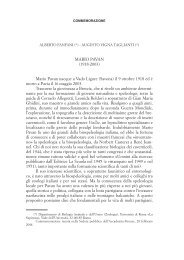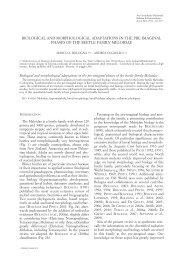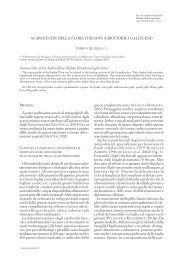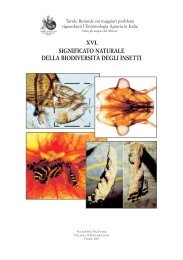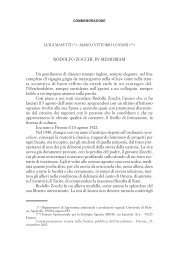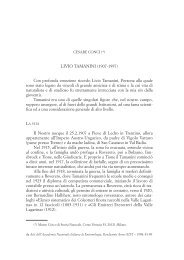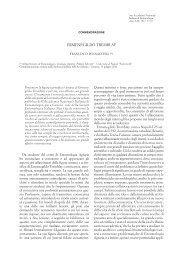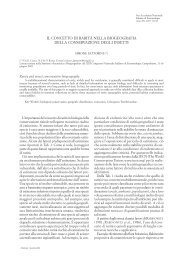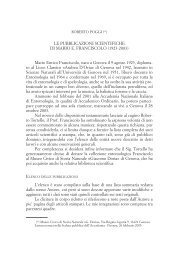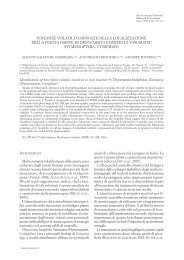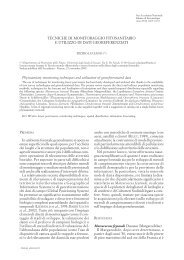XXII CNIE - Accademia nazionale italiana di Entomologia
XXII CNIE - Accademia nazionale italiana di Entomologia
XXII CNIE - Accademia nazionale italiana di Entomologia
You also want an ePaper? Increase the reach of your titles
YUMPU automatically turns print PDFs into web optimized ePapers that Google loves.
attributes. The <strong>di</strong>stribution, size and clustering of neuronal somata are useful characters<br />
as are the recognition of specific geometries of neuropil subunits, such as columns,<br />
glomeruli, and other <strong>di</strong>screte structures such as wedge-like domains (Strausfeld, 1998).<br />
For any taxon, characters have been scored as either being present (1) or absent (0) for<br />
more than thirty species representing the major arthropod groups. It is important to avoid<br />
biasing the data set by assuming specific functions or identities. For example, with<br />
regard to mid-line neuropils that appear to be present across the crustaceans and insects,<br />
all that can be scored is whether they are modular, the numbers of modules, and whether<br />
their contributing neurons derive from remotely positioned somata or somata that are<br />
imme<strong>di</strong>ately adjacent to the center (Strausfeld et al., 2006). Thus far, over 130 characters<br />
have been identified and are used to construct a matrix in which their presence of<br />
absence is scored for 35 or so species (inclu<strong>di</strong>ng one outgroup species, either the<br />
polychaete annelid Arctonoe fragilis or Nereis bicolor) representing many of the major<br />
arthropod groups. To minimize bias, characters are treated as unlinked, unordered and<br />
equally weighted. They are not assigned character states and nor functional affiliations.<br />
Once such a large matrix is assembled, it is then analyzed using special statistical<br />
programs designed to resolve the degree to which the species investigated share<br />
structural affinities, thus provi<strong>di</strong>ng the most parsimonious relationships amongst them<br />
(Swofford 2002). Species used for such reconstructions represent their wider taxonomic<br />
classes. For example, for the enigmatic Onychophora (velvet worms), a lobopod group<br />
<strong>di</strong>stantly related to lobopods that characterize lower Cambrian fossil beds, three species<br />
have been used, two peripatopsids, Euperipatoides rowelli and Phallocephale<br />
tallagandensis and an un-named peripatid species from the Mazatlan peninsula.<br />
Although from two continents, Australia and S. America, their central nervous systems<br />
show no detectable <strong>di</strong>fferences in organization, suggesting extreme phyletic stability<br />
over a period of 237 million years, since the break up of the super continent of<br />
Gondwanaland. Likewise, the central nervous systems of Old World and New World<br />
scorpions (from the Sahara and from the Sonoran Desert) show comparable stability.<br />
Neural phylogenies sample both scutigeromorph and scolopendromorph Chilopoda<br />
(centipedes), and Diplopoda (millipedes) from Asia and America. Likewise, species of<br />
araneans (spiders) include primitive Liphistiidae from Asia, wandering spiders, orb<br />
weavers, and salticids or jumping spiders. Included too are other chelicerates, such as the<br />
vinageroon and whip spiders. Species include several apterygote, palaeopteran and<br />
neopteran insects along with the entomostracan crustaceans Triops and Artemia,<br />
reptantian species, such as crabs, and non-reptantian malacostracans. The latter include<br />
members of the Isopoda, Stomatopoda, and Phyllocarida, the first representing a highly<br />
derived group of Eumalacostraca, the last representing what is thought to be the most<br />
basal malacostracan taxon.<br />
Once assembled, a heuristic search of the data matrix, employing about a thousand<br />
random stepwise ad<strong>di</strong>tion replicates, provides unrooted relational trees, the most<br />
parsimonious of which provide a comprehensive arthropod phylogeny. What is striking<br />
about this is that in most respects an optimal tree is congruent with phylogenies resolved<br />
by molecular phylogenies. There are, however, two notable exceptions to this. The first<br />
is that the Onychophora, long assumed to be related to, but not included in the<br />
Euarthropoda, is revealed by neural cla<strong>di</strong>stics to be within the Euarthropoda and basal to<br />
the chelicerates (e.g. Limulus, araneans, scorpions, Pycnogonidae). The second<br />
exception refers to the position of the insects. For some years insects have been admitted<br />
as a sister group of the crustaceans on the basis of shared ommati<strong>di</strong>al structures (Dohle<br />
2001), insects and crustaceans provi<strong>di</strong>ng the clade Tetraconata, also termed the<br />
Pancrustacea. Molecular phylogenies support this affinity, but in<strong>di</strong>cate that the Insecta<br />
22



